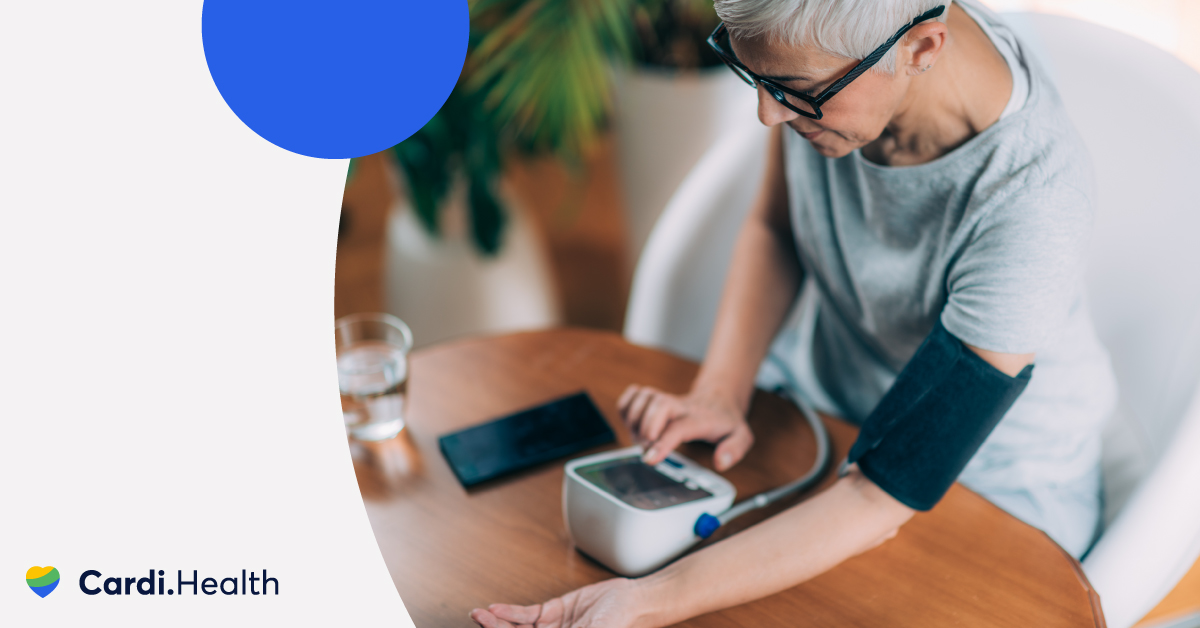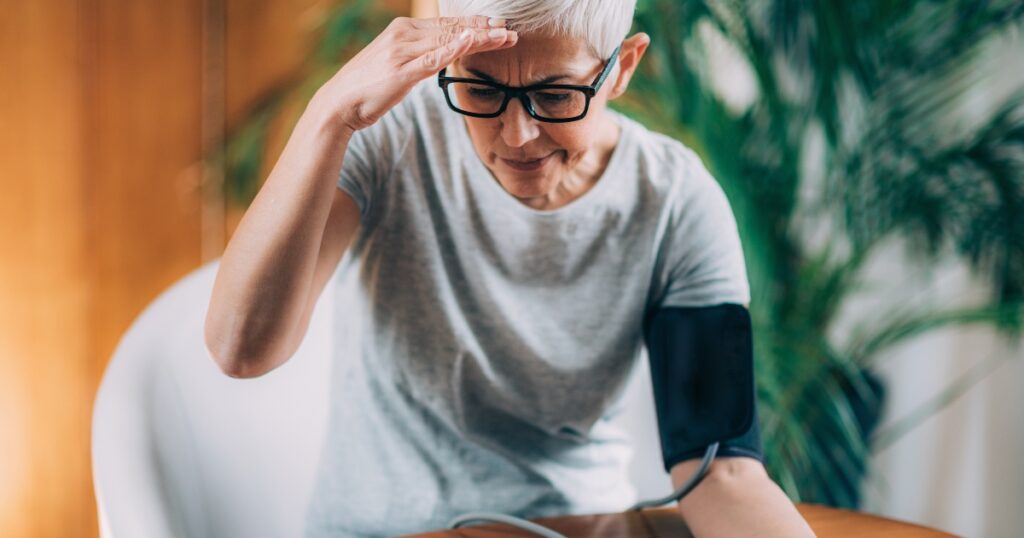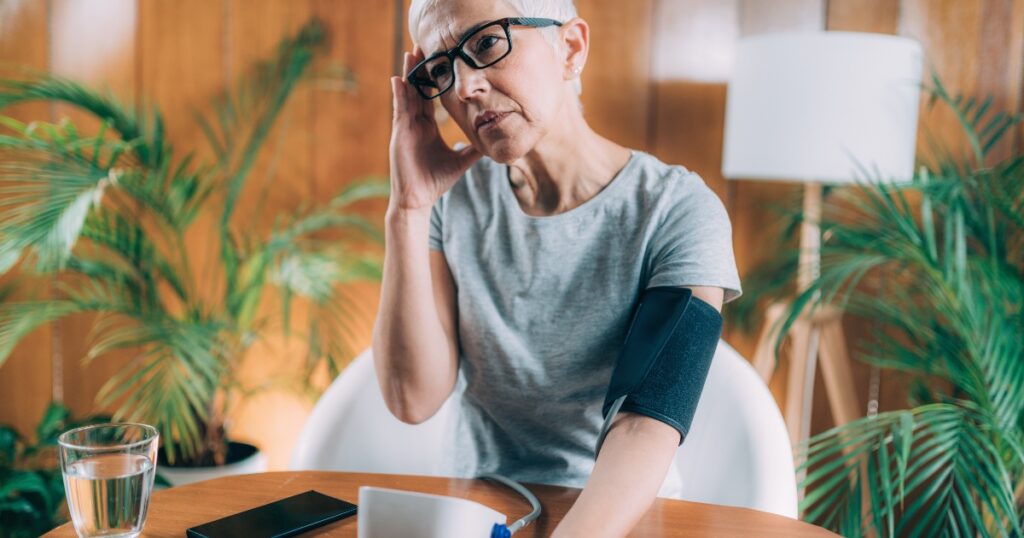Decoding the Drop: Why Your Second Blood Pressure Reading Might Differ
Your BP reading is a great predictor of your cardiovascular health. It can show the stress your heart and blood vessels are going through. The best part is you can measure it at home in a minute.
You might notice that your second blood pressure reading tends to be different – specifically, lower. This article aims to show you why. Let’s get into it.

Master your heart health now
Take part in our 60sec quiz and get a heart health plan tailored just for you.
Contents
The Science Behind Blood Pressure Readings
When you take your blood pressure reading, you’ll see two numbers. The first is your systolic blood pressure, which is the force your blood exerts on your blood vessels when your heart contracts. The second is diastolic blood pressure, which is the force when your heart is relaxed.
Blood pressure readings are obtained using a blood pressure monitor to measure minute movements caused by your blood flow with each heartbeat.
External factors like your blood pressure cuff size and your arm positioning can affect the reading. Other factors, like anxiety, a full bladder, and white coat syndrome, can too.
Start managing your heart health now!
Find out what works for you with this 60sec quiz.

Why Is Blood Pressure Lower the Second Time You Take It?

You should take at least two BP readings when you check it. You might notice you always get a lower blood pressure reading the second time.
As many as two out of five people with their first blood pressure reading high dropped out of the hypertensive range on the second reading. Here are some reasons why:
- Relaxation. It’s always advised that you sit quietly for a bit before starting your blood pressure measurement. The time spent during the first blood pressure reading can relax you and result in a lower reading the second time.
- White coat syndrome. The hospital environment can give anxiety that causes temporary high blood pressure. This is called white coat syndrome. Getting your BP checked by a doctor during a medical appointment can cause a first blood pressure reading that is higher than the one you take immediately after you get home.
- Reduced effects of substances. Tobacco, alcohol, caffeine, and other drugs can cause acutely high blood pressure readings. BP readings that come later can give enough time for the effects to weaken.
- Environmental distractions. A lot of noise when you’re doing your BP measurement, can lead to a higher reading on the first measurement. These distractions might stop, or you might get used to them by the time you take the next reading.
The Importance of Multiple BP Measurements
Each time you measure your blood pressure, you want to take at least two measurements. This is because your blood pressure fluctuates throughout the day due to different factors.
Considering that your first reading might be higher than the second, the best way to get an accurate blood pressure reading is to take two BP measurements a minute apart and then get the average.
Also, doing your BP measurement in the morning and evening can give you a better understanding of the factors that can influence your blood pressure readings.
For instance, is it higher when you get back from work? Is it increased after you come back from your jog or eat a large meal? If you have hypertension, these things can be helpful to understand.
Best Practices for Blood Pressure Measurement

When you live with high blood pressure, you’ll end up taking your readings at home rather frequently. You should know the dos and don’ts for the most accurate reading.
Preparation before measurement
The things that you do before you check your BP can have a big impact on the reading. The tips below can improve the accuracy.
- Rest. Resting in a chair for 5–10 minutes can significantly lower blood pressure readings.
- Restrict your diet. Measure before you eat breakfast or at least 30 minutes after. Also, avoid your morning coffee or alcohol until after the reading.
- Have an empty bladder. It’s been recognized that a full bladder can increase your BP, so make sure to pee beforehand.
Proper positioning and environment
Your body’s position and the things around it can affect blood flow, and this can potentially result in high blood pressure readings.
- Position your arm properly. Place and relax your forearm on a chest-level surface with your palm facing upward. Having your arm on an armrest can increase systolic pressure and diastolic pressure.
- Sit with the correct posture. You should sit in a comfortable chair with your back straight and rested and your feet flat on the ground.
- Ensure a calm environment. Don’t take your blood pressure reading in an environment with too much noise, as this can increase the measured BP.
Cuff considerations
With a digital monitor, the cuff is responsible for actually detecting your systolic blood pressure and diastolic blood pressure.
- Ensure the right cuff size. A 2023 study showed that smaller cuffs on your upper arm can lead to inaccurate higher diastolic and systolic pressure readings, while bigger cuffs can give false lower readings. Always use the appropriate size.
- Ensure proper cuff placement. Your cuff should be placed on the upper arm, and the center of the bladder (labeled on the cuff) should align slightly on the inside of your bicep. Poor placement can cause a minor difference in your reading.
Start managing your heart health now!
Find out what works for you with this 60sec quiz.

During the measurement
The things you do before taking your first reading are important, but so are the things you do as your BP is being measured.
- Stay as still as possible. You want to aim to make as few movements as possible, as increased activity can bring up your heart rate and affect your BP reading.
- Take more than one reading for accuracy. If you manage high blood pressure, you should aim to take at least two readings and find the average. You can discard any reading that is much higher (>10mmHg) than the others (usually the first).
Consistency and record keeping
As you manage your high blood pressure, it is important to be consistent. This way, each systolic reading and diastolic reading is replicated under the same conditions.
- Always use the same arm. It is absolutely normal to get different BP readings in each arm. But this means that using the left today and the right tomorrow can cause false concern of high blood pressure, so stick to the same limb, preferably the left.
- Check your BP at the same time every day. Your BP goes through natural fluctuations throughout the day, so it is important to maintain a specific time of each day.
- Maintain a BP log. If you have high blood pressure, measuring consistently is good, but recording consistently is better. Using a blood pressure log like the one in the Cardi Health app can help detect positive or negative trends and help you and your doctor find the cause.
FAQ

You asked why the blood pressure is lower the second time I take it, and hopefully, you understand why.
But, if you live with high blood pressure, there are other common questions you might have about blood pressure monitoring at home.
Why is my blood pressure different every time I take it?
Your blood pressure isn’t perfectly static, and small fluctuations based on changes in your body and sensor sensitivity are normal. Larger fluctuations can happen throughout the day due to stress, hormonal changes, physical activity, and more.
How long should you wait between two blood pressure readings?
You should have at least one minute between each blood pressure reading you take for the most accurate results.
Should you take blood pressure once or twice?
Each time you bring out your BP monitor, get at least two readings. You can check your BP twice a day – morning and evening – especially when you’re just starting off. Your doctor can let you know when once a day is sufficient.
Start managing your heart health now!
Find out what works for you with this 60sec quiz.

Conclusion
Hypertension is a silent disease that poses a cardiovascular disease risk to a patient. It is important to understand the quirks of your blood pressure reading, such as why it might be lower the second time around.
Ensure that you check your BP regularly, but also make sure you visit your doctor regularly to get a professional opinion on your hypertension management.
Related articles
Best Foods to Lower Cholesterol
Does Caffeine Raise Blood Pressure?
Does Drinking Water Lower Blood Pressure?
Causes of High Blood Pressure at Night
10 DASH Diet Breakfasts for a Healthy Start
Heart-Healthy Diet Guide
What Should an 85-Year-Old Blood Pressure Be?
What is Normal Blood Pressure for a 70-Year-Old?
How to Read Blood Pressure: A Comprehensive Guide
Manage your heart health now
Find out what works best for you with this 60sec quiz and get your personalized heart health plan.

